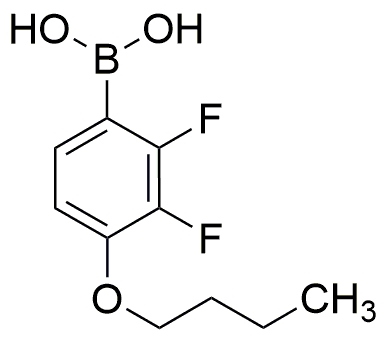4-Butoxy-2,3-difluorophenylboronic acid is widely utilized in research focused on:
- Pharmaceutical Development: This compound is crucial in synthesizing various pharmaceuticals, particularly in creating boronate esters that are essential for drug formulation.
- Organic Synthesis: It serves as a versatile building block in organic synthesis, allowing chemists to create complex molecules efficiently, which is particularly beneficial in the field of medicinal chemistry.
- Bioconjugation: The compound is used in bioconjugation processes, enabling the attachment of biomolecules to surfaces or other molecules, which is vital in developing targeted drug delivery systems.
- Material Science: It finds applications in the development of advanced materials, including polymers and nanomaterials, enhancing properties such as conductivity and strength.
- Fluorescent Probes: This chemical is employed in creating fluorescent probes for biological imaging, helping researchers visualize cellular processes with high specificity and sensitivity.
Informations générales
Propriétés
Sécurité et réglementation
Applications
4-Butoxy-2,3-difluorophenylboronic acid is widely utilized in research focused on:
- Pharmaceutical Development: This compound is crucial in synthesizing various pharmaceuticals, particularly in creating boronate esters that are essential for drug formulation.
- Organic Synthesis: It serves as a versatile building block in organic synthesis, allowing chemists to create complex molecules efficiently, which is particularly beneficial in the field of medicinal chemistry.
- Bioconjugation: The compound is used in bioconjugation processes, enabling the attachment of biomolecules to surfaces or other molecules, which is vital in developing targeted drug delivery systems.
- Material Science: It finds applications in the development of advanced materials, including polymers and nanomaterials, enhancing properties such as conductivity and strength.
- Fluorescent Probes: This chemical is employed in creating fluorescent probes for biological imaging, helping researchers visualize cellular processes with high specificity and sensitivity.
Documents
Fiches de données de sécurité (FDS)
La FDS fournit des informations de sécurité complètes sur la manipulation, le stockage et l’élimination du produit.
Spécifications du produit (PS)
Le PS fournit une description complète des propriétés du produit, notamment sa composition chimique, son état physique, sa pureté et les exigences de stockage. Il détaille également les plages de qualité acceptables et les applications prévues du produit.
Certificats d'analyse (COA)
Recherchez des certificats d'analyse (COA) en saisissant le numéro de lot du produit. Les numéros de lot et de lot se trouvent sur l'étiquette d'un produit, après les mots « Lot » ou « Lot de fabrication ».
Numéro de catalogue
Numéro de lot/série
Certificats d'origine (COO)
Ce certificat d'exploitation confirme le pays dans lequel le produit a été fabriqué, et détaille également les matériaux et composants utilisés et s'il est issu de sources naturelles, synthétiques ou autres sources spécifiques. Ce certificat peut être requis pour les douanes, le commerce et la conformité réglementaire.
Numéro de catalogue
Numéro de lot/série
Fiches de données de sécurité (FDS)
La FDS fournit des informations de sécurité complètes sur la manipulation, le stockage et l’élimination du produit.
DownloadSpécifications du produit (PS)
Le PS fournit une description complète des propriétés du produit, notamment sa composition chimique, son état physique, sa pureté et les exigences de stockage. Il détaille également les plages de qualité acceptables et les applications prévues du produit.
DownloadCertificats d'analyse (COA)
Recherchez des certificats d'analyse (COA) en saisissant le numéro de lot du produit. Les numéros de lot et de lot se trouvent sur l'étiquette d'un produit, après les mots « Lot » ou « Lot de fabrication ».
Numéro de catalogue
Numéro de lot/série
Certificats d'origine (COO)
Ce certificat d'exploitation confirme le pays dans lequel le produit a été fabriqué, et détaille également les matériaux et composants utilisés et s'il est issu de sources naturelles, synthétiques ou autres sources spécifiques. Ce certificat peut être requis pour les douanes, le commerce et la conformité réglementaire.


